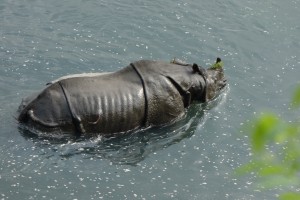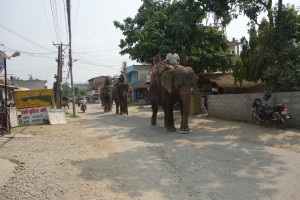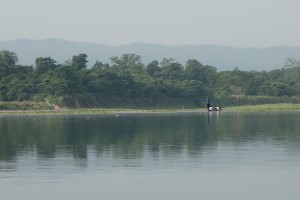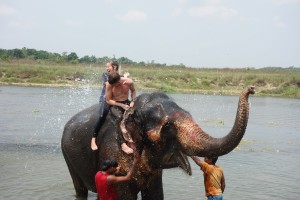We can say, with the benefit of hindsight, that the Annapurna Circuit trek is not something to be taken lightly. It is hard. A 12 day trek, through 140 km of Himalayan terrain, carrying the weight of your pack, battling against all the elements; wind, rain, sun, snow, altitude, stomach cramps, blisters; culminating in a climb to the Thorung La pass, at 5416 metres the highest in the Himalayas and just about as high as you can go before getting out the crampons and ice-picks.
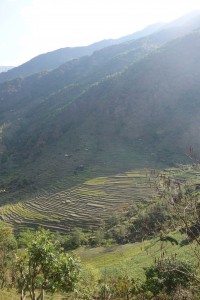
The Middle Hills
Contrast this to our preparation: a training regime made up largely of lounging in a hammock and adhering to a strict diet of rum and cigarettes. We even took the hammock for chrissakes, envisioning ourselves sauntering into the mountains, stringing up the hammock, then sauntering off after a few hours. I carried it all the way and used it not once.
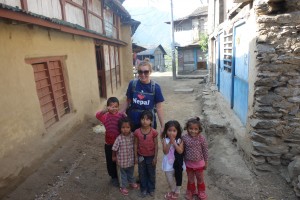
With that T-shirt she was bound to make friends.
Of course, there were rewards for our travails. It’s not without reason that this is one of the most popular treks in the world, the scenery was outstanding, and so varied. The trail started at Besi Sahar, in the warmer lowlands of the region. The first couple of days were spent winding through the Middle Hills, a tropical mountainous setting, bushy green and with haystacks, goats, cows, and hillsides carved with terraces reaching almost to the top, like giant staircases. Dotted along the way were tiny farming villages.
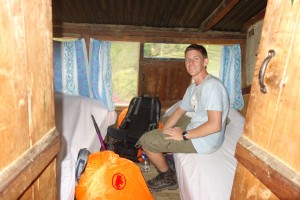
Not enough room to swing a goat.
It was these villages that provided us with succour and shelter, and lend the circuit it’s ‘tea-house trek’ status. This trek has been popular since the 1980s and over the years the locals have realised that they can make a few supplementary rupees from the continuous trail of Westerners panting past their door. These are not rich hoteliers, just individual families who’ve converted their dwellings into guest houses. Often we’d be the only people staying and would eat – and drink the local alcohol, rakshi – with the family. The kids chipped in too, they’d always seem so grown up, serving us tea or touting for custom, until with minimal encouragement they’d revert to being kids. A favourite game of Amy’s was to show them photos of themselves on the digital camera screen. One little girl made us take around 20 shots in different poses, some with a flower on her head, some with a cat. She showed no signs of quitting so eventually we had to say a semi-stern “No more!”. “And where’s our tea?”

Nepal’s Next Top Model
A typical day would be: awake at 6:30, breakfast pre-ordered, on the road by 7:30, break for lunch about midday, then arrival at destination by 15:00. After the Middle Hills the scenery began to alter; the terraces became more dishevelled and sparse as the valley sides grew a velvety green baize and slowly turned into a steep chasm. By day 4 things had become very British: a light drizzle chaparoned us through pine forests carpeted with brown needles and the smell of damp trees hung in the air. A mist enveigled the mountain forests. Chimneys chugged out puffs of woodsmoke, we even saw a football pitch at 3000 metres.
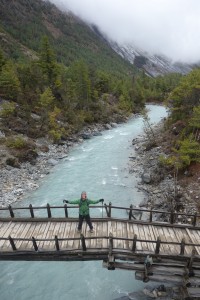
Inevitably the light drizzle turned to rain, a cold rain. This wasn’t so much of a problem in itself – we had wet gear and the strenuous walking meant we didn’t get too cold – but it did obscure our view of the peaks that the guide book promised we should’ve been seeing for the last two days. Each day seemed cloudier than the last and this began to get us down. Then, finally, at the end of day 5, when we were sitting in a guest house in Upper Pisang, the clouds unfurled to reveal Annapurna II in all it’s glory, chalky white against a bright blue sky. The sudden unveiling was perhaps more rewarding than a peek here, a peak there along the way.
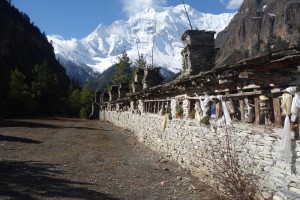
Annapurna II
The following day, although the hardest yet in terms of height and distance, turned out to be the most enjoyable. With the clouds vanquished we could see the white peaks, blue sky, green alpine forests, turquoise lakes and rivers, glaciers, moraines, crevasses, all cheering us on our way to Manang.
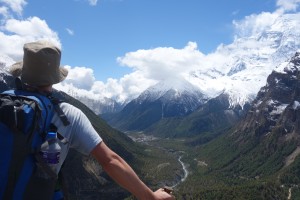
Nice hat.
So it was, with the wind harrying at our backs, that we hobbled into Manang, the promised land, where we were to have a rest and acclimatisation day. At Manang, altitude sickness was the subject of many a conversation, and the disturber of many a deep sleep. The Himalyan Rescue Association lay on a daily seminar on the subject and proudly claim that nobody who has attended has ever died from altitude sickness. We thought we’d best attend, to avoid the dying if nothing else. We also rested, and stocked up on factor 60 suncream for the days ahead. “There were times,” said Amy, “when I never thought I’d make it to Manang at all.”

Above Manang things really began to feel eerily separate from the rest of the world. We left the trees, the river, the paltry road behind and entered a strange boulder-strewn meadow land where the only sound was the occasional tinkling of a yak-bell. The snowy peaks got ever closer and the handful of villages now were seasonal only, existing only for trekkers making their way up to the Thorung La. It took 2 days to reach the base camp of the pass, Thorung Phedi.
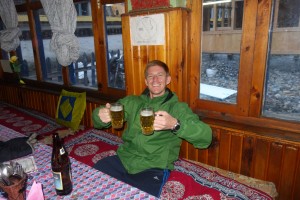
Well it had been a tough day.
This was it, this was what we’d been leading up to for the past 10 days. It had been tough – at times gruelling, one foot forward stuff; at other times head down, driving through the rain; there were definitely times when this whole merry escapade became my fault entirely and Amy scowled at me from beneath her woolly hat. But we’d made it this far. A camaraderie had developed amongst all of us who were attempting the pass the next day. We sat for dinner in a cabin heated by a wood fire while a snow storm howled around outside. A nervous tension reigned, and was only heightened when two Americans burst in from the darkness covered in snow. They’d attempted the pass that day but had had to descend due to altitude sickness. We all prayed that wouldn’t be us tomorrow, nobody fancied a 7 day retreat down the mountain.
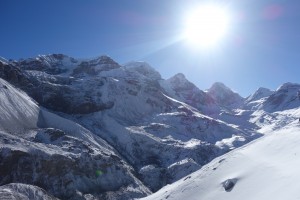
Sunrise at 5000m.
Up at 4:30, on the road by 5:30, the first challenge of the day was a climb up a frozen waterfall. Seeing the sun rise while being that close to so many gargantuan peaks was a treat, and the nighttime snowfall had carpeted everything with a white duvet. This was spectacular to look at, but made walking difficult – every so often one of our feet would fall 3 feet through the snow, and it completely covered the trail. Luckily we fell in with a French trio who had a guide. We walked single-file through the snow like a South Pole expedition. The setting was just awesome, ethereal: a deep, deep blue and a sparkling white was all we could see. The altitude took it’s toll though: the closer we got the slower we had to climb. Also, the higher you go the colder it gets but, paradoxically, the stronger the sun becomes. So we were in a situation where we were freezing cold but getting burnt alive. Our noses reddened and puckered and our lips boiled and blistered. But hang on a minute, what about that factor 60 sun-cream?

Made it!
There were so many false summits that the climb seemed to go on forever but finally we made it! We all hugged and high-fived and probably said something like “wooooo!”. We’d climbed over 1000 metres before lunch.

Intrepid husband and wife duo.
Still we had a knee-wrecking 5 hour descent. The scenery as we went down the other side was spellbinding, it appeared we’d entered some sort of mystical desert kingdom, over which and behind a whole new set of peaks the sun was setting. As we staggered into Muktinath we found ourselves being cheered on by almost all of the other trekkers we’d met along the way, like the cast of characters at the end of a film. There was the Australian girl, the Canadian couple, the Dutch guy, the North London Jew who’d taken an extra day because he observed the Sabbath, the Kiwi family (they really were a family, with two teenage daughters putting us all to shame), all showered, relaxed and drinking beer! We soon joined them and the sounds of raucous relief spread throughout the town.

Yaketty yak.
We were more than a little annoyed however, when we looked properly at our ‘Nivea Moisturiser with SPF 60 Protection’ and saw it was actually ‘Misturiser’. Fake sun-cream. We’d taken a battering from the sun, Amy especially, so jumped on a bus the next day. Two days, a trilogy of god-awful journeys, two flat tyres, a lost pair of Ray-Bans, a found pair of Ray-Bans, and a heated argument with a Frenchman who refused to vacate Amy’s seat, we got back to Pokhara; bedraggled and burned and bearded (me that is, not Amy) but ultimately very proud of ourselves.
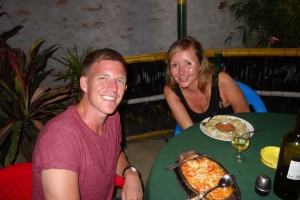 Certainly we weren’t so lazy as to disregard the park altogether. We opted for a morning ride in a dug-out canoe where it felt like we were floating down some tributary of the Amazon. The banks were lined with rushes and high grass, amongst which we saw a twitcher’s wet dream of birds: egrets, ibis, kingfisher, huge maribou stork and even bigger peacocks. Our guide floated us through the lilipads and vegetation close to the bank. “Crocodile!” he whispered urgently, pointing. None of us had seen it so he laboriously punted the canoe backwards. This time we saw it, about 2 feet underwater, the back half of an enormous man-eater, it’s tail as thick and long as a man’s leg, hiding like some relic of prehistory.
Certainly we weren’t so lazy as to disregard the park altogether. We opted for a morning ride in a dug-out canoe where it felt like we were floating down some tributary of the Amazon. The banks were lined with rushes and high grass, amongst which we saw a twitcher’s wet dream of birds: egrets, ibis, kingfisher, huge maribou stork and even bigger peacocks. Our guide floated us through the lilipads and vegetation close to the bank. “Crocodile!” he whispered urgently, pointing. None of us had seen it so he laboriously punted the canoe backwards. This time we saw it, about 2 feet underwater, the back half of an enormous man-eater, it’s tail as thick and long as a man’s leg, hiding like some relic of prehistory.